Why Is the Black and Red on Tlingit Art
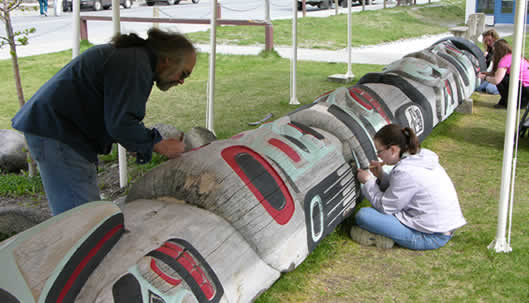
Local Mastercarver Jim Heaton instructs students during the 2005 restoration of the Haines High School Friendship Pole. This huge pole is a much larger reproduction of a pole presented to Steve and Bess Sheldon in 1927.
Tlingit people are artistic by nature and some folks would argue that their fine sense of workmanship and design is best exemplified through the medium of carving. Most Tlingit objects were carved from wood, the most readily bachelor and a highly usable substance. Other materials such as horn, copper and later silver were also decorated with carved and engraved figures.
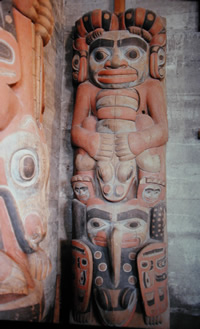
Worm woman house post from Klukwan, carved before 1800.
The unique pattern elements or patterns used past traditional Tlingit carvers vest to what has get known as the Northwest Coast form-line style. This style, quite hands recognizable, portrayed creatures from the natural world in varying degrees of realism. Ofttimes they were divide or fragmented with eyes, joints, fins, feathers or some other easily recognizable feature delineated with broad black grade-lines. Traditional colors were a green-blue and ruby. The grade-line style blueprint, present from Yakutat to Washington State has subtle stylistic differences in each region. Tlingit motifs may be classified equally Northern Northwest coast Indian art, a distinct style seen from approximately Bella Coola to Yakutat Bay.
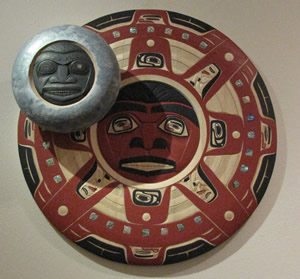
"Eclipse," by local Mastercarver Jim Heaton. This slice measures virtually three feet beyond, 2011.
At one fourth dimension Tlingit carving was considered important by the outside world for its ethnological value. However, at the San Francisco Exposition of 1939, and after at a 1941 exhibit at the Museum of Modernistic Art in New York City, Tlingit carving was displayed equally art. Now it is a widely acknowledged fine art form highly praised past art lovers worldwide. Many modern Tlingit artists continue to carve in the traditional style.
Carving Tools and Materials
- Adzes
- Adzes came in a variety of sizes. Before the introduction of iron they were fabricated of rock. The adze was used to hew out a grade.
- Axes
- Axes were used for splitting wood.
- Drills
- Drills were used for making holes by rotating the betoken in a slice of wood. The holes were then used for sewing or tying parts of an object together.
-
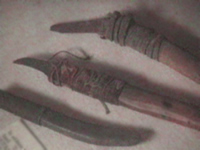
Knives with manus-made metal blades. - Knives
- Earlier the introduction of metallic, knives were made of stone, bone or beat out. The many shapes and sizes were fabricated to fit the purpose and the carver'due south hand. Etching knives were used for dissimilar mediums including forest and metals.
- Wood
- Both red and yellow cedar were highly prized for carving dugout canoes and totemic poles. Information technology separate along a directly grain and was thereby valuable for planks. Cottonwood was used for making small dugout canoes. Since it did non transfer taste to nutrient, alder was the preferred wood for etching dishes and utensils. Local birch is used by many contemporary carvers for its lovely grain.
- Horn
- Both goat and sheep horn were carved, usually into handsome feasting spoons.
- Metallic
- Gold and silverish coins were hammered into shapes and engraved. Copper from the interior was also used for items such as knife blades and Tinnés.
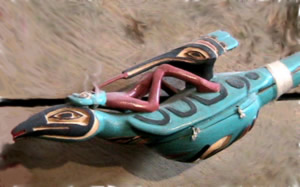
Beautifully carved Raven Rattles, were used for ceremonial purposes by dancing chiefs and shamans.
Tlingit carvers full-bodied their most decorative efforts on ceremonial and shamanic fine art. Staffs, masks and rattles were decorated for potlatch songs and dances and for other rituals such as healing conducted past the shaman. The most lavishly carved eating utensils and bowls were saved for potlatches while those used for everyday meals were just decorated. Carved bentwood boxes stored food supplies, ceremonial clothing, or were used for cooking by dropping hot stones into a box filled with h2o. Huge screens, used to divide the living quarters within a house, were ornately carved, often with a family or clan crest.
Houseposts and Totem poles

This 30 inch Friendship Pole was presented to Steven and Elisabeth "Bess" Birkinbine Sheldon in 1927 in gratitude for their friendship and help in promoting understanding among the houses and clans of the Chilkat People. Carved by Jim Watson, a Raven originally from Klukwan, and deputed by the Eagle Moiety also of Klukwan, the pole is unique for its time in that both Raven and Eagle announced on it. 2 stories are also represented by the Friendship Pole: "Raven Feeding the People" and "Militarist Brings Fire." Militarist, as a helper of the people, represents the Sheldons.
Traditional totem poles draw crest figures such as animals, people, natural forms, or supernatural beings that identify a family's history or tell important stories. They were raised for many reasons: to dedicate a new house, commemorate a marriage, honor the deceased, or celebrate a special effect. The person raising the pole told the carver which crests to use only the carver designed the pole and represented the crests as he wanted. Raising a totem pole affirmed the condition and wealth of the person and association who commissioned the pole. Stories pertaining to the pole were told during a potlatch held to dedicate the pole.
As a result of increased wealth the peak of totem pole carving occurred in the 1860's and then declined quickly, probably due in part to the banning of potlatches in 1884 (since repealed). The carving of house posts was abandoned in the late 19th century when Western fashion houses replaced communal houses. Many of the poles from the 19th century were eventually felled, destroyed, sold or removed. For several decades the art of carving totem poles declined and appeared to be doomed. In the 1960's an appreciation for totem poles was renewed and several Northwest Coast Native carvers revitalized the fine art. Near of the poles seen today are under a century old.
Canoes
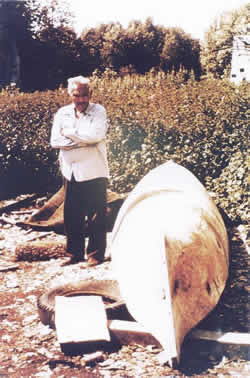
Archie Kleney, 1978. This still unfinished dugout canoe is on display at the Sheldon Museum.
Canoes were the major ways of transportation for coastal Tlingits. Pocket-size canoes were made for both men and women, large ocean-going canoes were owned by family groups. Not bad skill was required to fashion a dugout canoe such as the i on exhibit at the museum (right). First an advisable tree was selected, cottonwood for a small canoe and red or yellow cedar for a larger one. Carmine cedar was the favored wood, simply it grows mainly in the land of the Haida Indians south of Tlingit territory. The Tlingits traded with the Haidas for the prized large cedar.
The log was showtime hollowed out with an adze then shaped past a process which involved filling it with water heated to a near boil with hot rocks. Hot steam penetrated the log making it soft and workable. At this point boards were forced between the sides, pushing them to the desired shape. The boat was then dried and smoked over a pitch burn that too blackened the forest. In the instance of larger canoes, split pieces were added to form the loftier prow and stern. Big canoes oftentimes had a carved figure on the prow and some were painted with crests and emblems. A waterproof, durable paint was made past mixing minerals, salmon eggs and chewed spruce gum and applied with a behave or porcupine hairbrush.
Barbara Waterbury, 1987
Bibliography:
Billman, Esther. Tlingit Bull. Num. one. Sitka: Sheldon Jackson Museum Press. 1975.
Halpin, Marjorie One thousand. Totem Poles: An Illustrated Guide. Vancouver:
University of British Columbia Press. 1981.
Holm, Pecker. Northwest Declension Indian Art: An Analysis of Form. Seattle Academy of Washington Press. 1965.
Jonaitis, Aldona. Art of the Northern Tlingit. Seattle: University of Washington Press. 1986.
Krause, Aurel. The Tlingit Indians. Translator: Gunther Erna, l956. Seattle: Academy of Washington Press. 1885.
antonieffthonflused.blogspot.com
Source: https://www.sheldonmuseum.org/vignette/tlingit-carving/